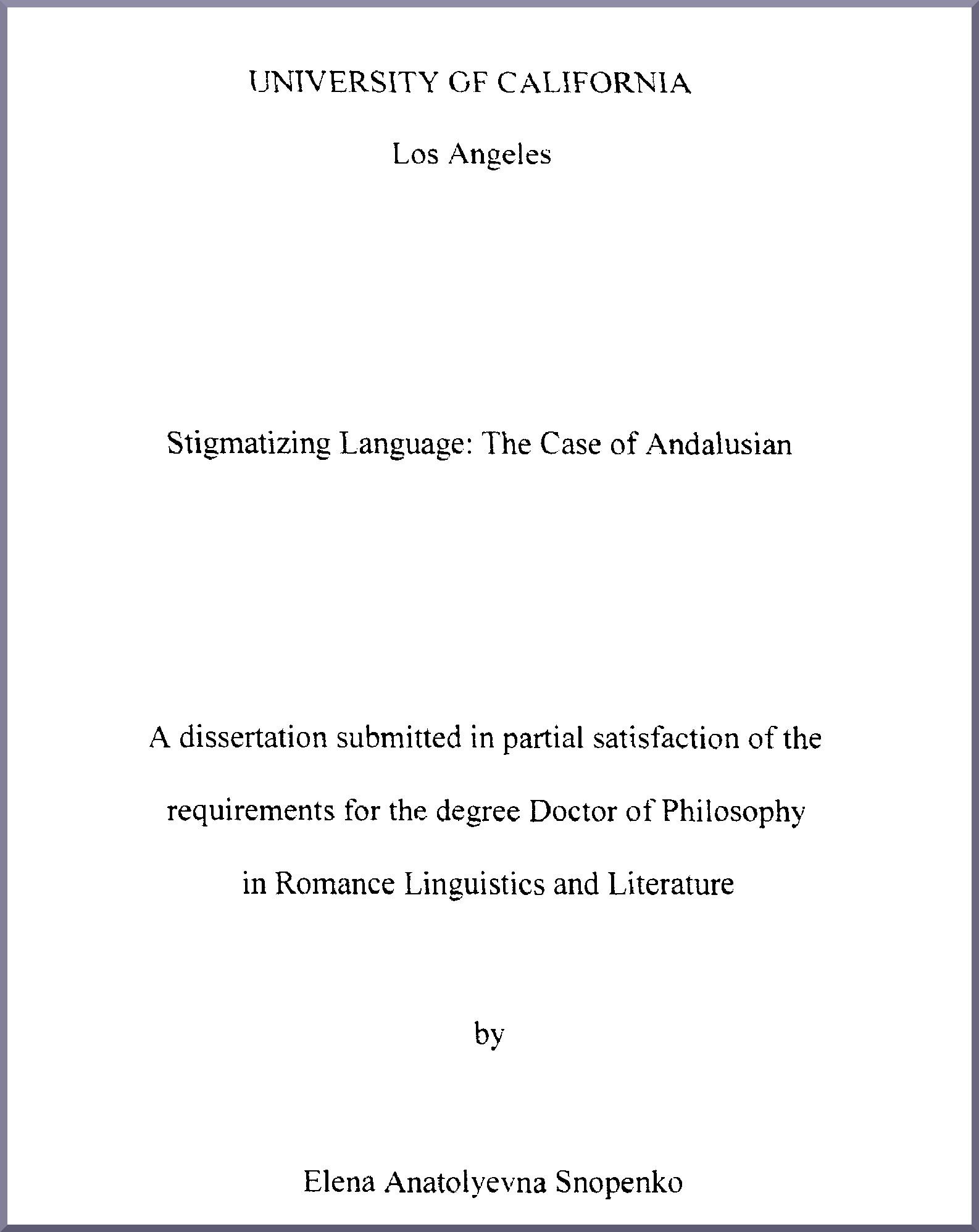Huente: ProQuest Dissertations Publishing; 2007
Tezih dohtorá de la linguihta ukraniana Elena Anatolyevna Snopenko «… for the degree Doctor of Philosophy in Romance Linguistics and Literature by Elena Anatolyevna Snopenko 2007 UMI Number: 3317013…» Defendía en la University of California Los Angeles en 2007.
Traduzión der título al andalú: Lengua ehtihmatizante. Er kazo del andalú. Obra ezenziá en la linguíhtika andaluza kontemporania pa ehkurkà loh oríheneh ihtórikoh del ehtihma pazia la kumunidá andalopahlante en er kohtehto kahteyanozéntriko del ehpañolihmo linguíhtiko./
Stigmatizing Language. The Case of Andalusian. Dissertation by the Ukrainian linguist Elena Anatolyevna Snopenko, defended in 2007 at the University of California Los Angeles. Fundamental work in contemporary Andalusian linguistics to discover the historical origins of the stigma towards the Andalusian-speaking community in the Castilian-centric context of the linguistic Spanishism ideology. /
Tesis doctoral de la lingüista ucraniana Elena Anatolyevna Snopenko, defendida el año 2007 en la Universidad de California Los Ángeles. Traducido al castellano el título sería así: Lengua estigmatizante. El caso del andaluz. Obra fundamental en la lingüística andaluza contemporánea para investigar los orígenes históricos del estigma hacia la comunidad andaluz-hablante en el contexto castellanocéntrico de la ideología del españolismo lingüístico.
• Pa zehkargà / To download / Descarga > Snopenko, E. A. – Stigmatizing Language. The Case of Andalusian.PDF
ABSTRACT OF THE DISSERTATION
Stigmatizing Language: The Case of Andalusian
by
Elena Anatolyevna Snopenko
Doctor of Philosophy in Romance Linguistics and Literature
University o f California, Los Angeles, 2007
Professor Claudia Parodi-Lewin, Chair
Stigma is a complex phenomenon and its conceptualization is based on multidisciplinary approach. Stigma was first explored in the framework of social psychology by Ervin Goftman (1965). In sociolinguistics, stigma is viewed in the relationship to language variation and change, and more specifically, it is linked to prestige and speakers’ linguistic awareness. According to William Labov (1967), prestige and stigma affect speaker’s linguistic choices and could result in language change. As a technical term, stigma is used in various sociolinguistic contexts, such as standardization, diglosia, language ideology. However, language stigma has never been systematically examined. In this study we develop the first comprehensive analysis o f stigma in language and apply the afore..lentioned theoretical observations to the linguistic situation of the sixteenth-century Spain. I argue that as a result o f the policy o f political unification and linguistic standardization the dialect of Andalusia was stigmatized.
I view language stigma as a result of mapping linguistic variation onto social hierarchy. Since stigma can be observed in the linguistic attitudes, 1 look at the expression o f the stigma o f andaluz in the attitudes of eruditos, in the construction of stereotypical characters in the theatrical performances, and in the literary debates in the XVI century. The data gathered shows that at least since the XV century the Spanish speakers were aware o f the Andalusian variety. The emergence of the Andalusian dialect in the speaker’s consciousness was accompanied by its negative evaluation. In fact, the Andalusian dialect was labeled in negative terms as “impuro”, “mezclado”, “cerrado”, etc. This attitude was rooted in its comparison with the toledano and later on with the madrileno, the two prestigious varieties of Castilian, which were considered superior to Andalusian.
In theater, stigma o f Andalusian was manifested in stereotypical comic characters, whose speech contained Andalusian features. The pronunciation of Andalusians served as a source of caricaturistic accents of marginalized and stigmatized groups presented on the stage.
The analysis of the debate between Herrera and el Prete Jacopin demonstrates that the stigma o f andaluz was a result of power struggle between Andalusian and Castilian writers for cultural dominance. The debate was caused by conflict of interests when the Adalusian Herrera attempted to re-evaluate his language and his position in the social hierarchy.
Goffman (1965) along with other students of stigma argued for the universality o f the phenomenon. Although the concept of stigma is universal, perceptions of what constitutes stigma vary from one society to another. This is due to different ideologies that form cultural attitudes and beliefs. I examine the language ideologies that framed stigma of the Andalusian dialect. In the 1 chapter, I discuss the terms andaluz and andalucismo and I demonstru. the ideological character o f these representations in the works of historical linguists, such as Menendez Pidal and Amado Alonso. Menendez Pidal, providing descriptive analysis of linguistic processes, accompanied it with an ideologically charged interpretation. His ideas, such as “Castilla la cuna de Espana”, “castellano el dialecto revolucionario”, assign inherently superior qualities to Castilian variety and, thus, map social hierarchies onto language and assume an inferior position o f the Andalusian dialect.

